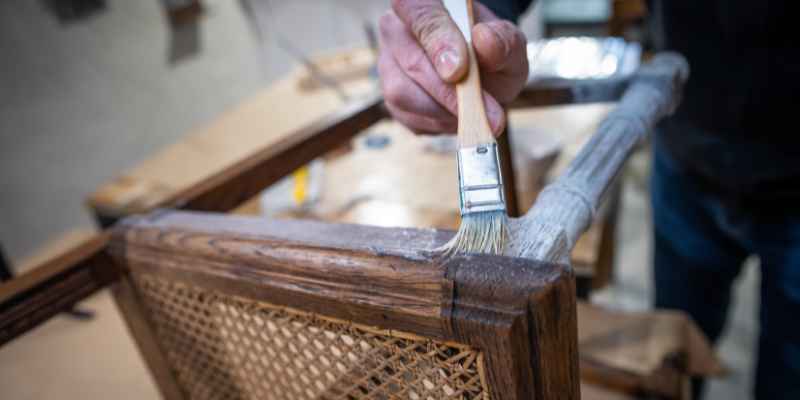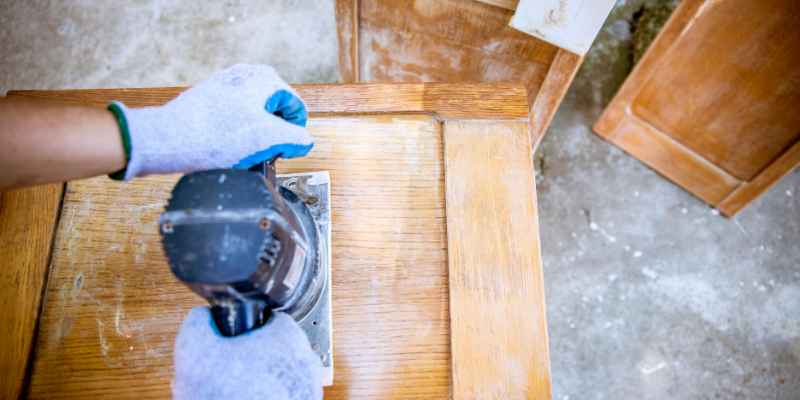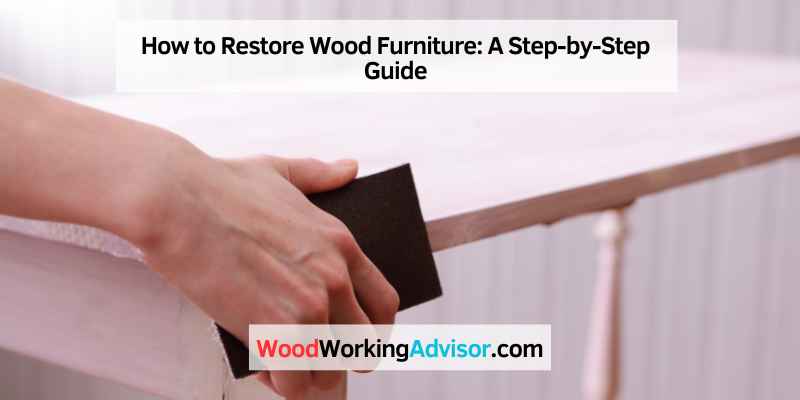To restore wood furniture, start by cleaning the surface with a gentle wood cleaner. Then, apply a wood polish or wax to bring back its shine and protect it from damage.
Restoring wood furniture can enhance its appearance and prolong its lifespan, making it a worthwhile investment for your home. Whether you have an antique piece or a modern design, proper restoration techniques can revitalize the beauty of your furniture. By following the right steps and using quality products, you can transform your wood furniture into a stunning focal point in your living space.
Ready to bring new life to your old wood furniture? Let’s explore the process of restoring wood furniture together.
Introduction To Wood Furniture Restoration
The Allure Of Restoring Wood Furniture
Restoring wood furniture can breathe new life into old pieces, allowing you to preserve cherished heirlooms or rescue forgotten treasures. Whether it’s a vintage dresser, a family dining table, or a flea market find, the process of restoring wood furniture can be incredibly rewarding.
Tools And Materials Needed
Before embarking on a wood furniture restoration project, it’s essential to gather the necessary tools and materials. The following list outlines the basic items required to successfully restore wood furniture:
- Sandpaper (various grits)
- Wood filler
- Stain or paint
- Paintbrushes or foam brushes
- Protective finish (varnish or polyurethane)
- Clean rags or tack cloth
- Wood glue
- Scraper or putty knife
- Screwdriver or drill (for hardware removal)
Assessing The Furniture’s Condition

Before starting the restoration process, it is crucial to evaluate the furniture’s current condition. The first step is to identify the types of damage that need to be addressed.
Identifying Types Of Damage
Scratches, dents, watermarks, and discoloration are common types of damage that furniture can experience over time. Scratches and dents can be caused by accidental impacts or regular wear and tear. Watermarks and discoloration, on the other hand, can be caused by exposure to moisture or sunlight.
It is essential to identify the specific type of damage to determine the best restoration technique. For instance, scratches and dents may require sanding and refinishing, while watermarks may require light sanding and re-polishing.
Deciding On The Extent Of Restoration
After identifying the types of damage, the next step is to decide on the extent of restoration needed. This decision should be based on the furniture’s age, value, and sentimental significance.
If the furniture is an antique or has sentimental value, it is recommended to preserve as much of the original finish as possible. In this case, light restoration techniques, such as cleaning and polishing, may be sufficient. However, if the furniture is not valuable or has significant damage, more extensive restoration techniques may be required.
It is crucial to consider the cost of restoration versus the value of the furniture. If the cost of restoration outweighs the value of the furniture, it may be best to leave it as is or consider replacing it.
Assessing the furniture’s condition is a crucial step in the restoration process. By identifying the types of damage and deciding on the extent of restoration needed, you can ensure that the furniture is restored to its former glory while preserving its value and sentimental significance.
Cleaning And Prepping The Piece
To restore wood furniture, cleaning and prepping the piece is crucial. Begin by removing any dirt and dust with a soft-bristled brush or cloth. Then, use a wood cleaner to remove any built-up grime or stains. Sand the surface lightly and wipe it down with a clean cloth before moving on to the next step in the restoration process.
Removing Dirt And Old Finish
To start, remove dirt and old finish using a soft cloth and wood cleaner.
Sanding Techniques For A Smooth Base
Use fine-grit sandpaper in circular motions for a smooth base.
Repairing Damage
Restore wood furniture by repairing damage with simple steps. Start by sanding the surface gently, then apply wood filler to any cracks or holes. Finish by staining or painting to bring new life to your furniture.
When it comes to restoring wood furniture, one of the essential steps is repairing any damage it may have sustained over time. Scratches, dents, water damage, and warping are common issues that can detract from the beauty and functionality of your wooden pieces. Fortunately, with the right techniques and tools, you can easily fix these problems and bring your furniture back to life.
Fixing scratches and dents
Scratches and dents are inevitable on wood furniture, especially if it has been well-loved and used. But fret not, as there are simple methods to repair these imperfections. For minor scratches, using a walnut or pecan can work wonders. Simply rub the nut against the scratch, and the natural oils will help fill it in. For deeper scratches or dents, consider using wood filler. Apply a small amount to the affected area, smooth it out, and let it dry. Once dry, sand the area gently until it is level with the surrounding wood. Finish off by applying a matching stain or sealant to blend in the repaired spot seamlessly.
Dealing with water damage and warping
Water damage and warping are more severe issues that require careful attention. If your wood furniture has suffered water damage, start by removing any excess moisture immediately. Use a clean cloth to blot the area and set up a fan to facilitate drying. Once the wood is dry, assess the damage. If there are white stains or rings, you can try removing them with a mixture of equal parts vinegar and olive oil. Apply the mixture to the affected area, let it sit for a few minutes, and then wipe it off with a clean cloth. For more extensive water damage, consider sanding down the affected area and then refinishing it.
Warping, on the other hand, occurs when the wood loses its original shape due to exposure to moisture or extreme temperatures. To fix this issue, you will need to apply heat and pressure to the warped area. One method is to use a clothes iron and a damp cloth. Place the damp cloth over the warped area and run the iron over it on a low heat setting. The steam and heat will help the wood fibers relax and return to their original shape. Another option is to use clamps or weights to exert pressure on the warped area. Leave them in place for a few days to allow the wood to slowly straighten out.
By following these methods, you can effectively repair scratches, dents, water damage, and warping on your wood furniture. Remember to take your time and be gentle during the restoration process to avoid causing further damage. With patience and the right techniques, you can revive your beloved wooden pieces and enjoy their beauty for years to come.
Stripping Old Finish
Reviving the beauty of wood furniture starts with stripping the old finish. Learn how to effectively remove layers of varnish or paint to uncover the natural allure of your cherished pieces. Discover step-by-step techniques and expert tips for a successful wood furniture restoration project.
Choosing The Right Stripper
When stripping old finish from wood furniture, selecting the appropriate stripper is crucial. Consider the type of finish on the furniture to determine the best stripper to use.
Application Tips For Best Results
For optimal results when stripping old finish from wood furniture, follow these application tips:
- Ensure proper ventilation when working with strippers.
- Apply the stripper evenly using a brush or cloth.
- Allow the stripper to sit for the recommended time before scraping.
- Use a scraper to remove the old finish gently.
- Repeat the process if necessary to completely remove the finish.
Stripping old finish from wood furniture requires the right approach to achieve the desired results. Carefully selecting the appropriate stripper and following proper application techniques can help restore the beauty of your furniture.
Applying New Finish
After stripping and sanding the wood furniture, it’s time to apply a new finish. The finish you choose will depend on the type of wood and the desired look.
Selecting The Finish Type
There are various types of finishes available such as oil-based, water-based, lacquer, and shellac. Oil-based finishes are easy to apply and provide a warm amber glow. Water-based finishes dry quickly and are eco-friendly. Lacquer finishes are durable and glossy, while shellac finishes are easy to apply and give a natural look.
Before selecting the finish type, consider the purpose of the furniture and the level of maintenance you are willing to undertake. For example, if you want a high-gloss finish for a dining table, a lacquer finish may be ideal. However, if you want a natural look for a side table, a shellac finish may be more appropriate.
Techniques For Even Application
Applying a new finish requires skill and patience. Here are some techniques for ensuring an even application:
- Use a brush or a sprayer to apply the finish in long, even strokes.
- Work in a well-ventilated area to avoid inhaling fumes.
- Apply the finish in thin coats and allow each coat to dry completely before applying the next one.
- Sand lightly between coats to remove any imperfections and ensure a smooth finish.
Remember to follow the manufacturer’s instructions for the specific finish you have chosen.
By following these tips, you can restore your wood furniture to its former glory and give it a new lease of life.
Reassembling And Detailing
After carefully restoring the individual parts of the wood furniture, it’s time to reassemble and add the final details to bring the piece back to its former glory. This stage requires patience and attention to detail as it can make a significant difference in the overall appearance of the furniture.
Putting Pieces Back Together
Start by referring to any documentation or photos taken during the disassembly process to ensure that each piece is put back in its correct position. Lay out all the components in an organized manner to make the reassembly process smooth and efficient. Use the appropriate tools to secure the pieces together, ensuring a snug fit without causing any damage to the restored surfaces.
Adding Final Touches
Once the furniture is reassembled, it’s time to add the final touches that will enhance its visual appeal and durability. Apply a suitable wood finish or protective coating to safeguard the restored surfaces from wear and tear. Additionally, consider adding decorative elements such as new hardware or embellishments to complement the refreshed look of the furniture.
Maintenance And Care
Maintenance and Care of wood furniture is essential for preserving its natural beauty and ensuring longevity. By implementing regular cleaning practices and protective measures, you can safeguard your wood furniture from damage and maintain its luster for years to come.
Regular Cleaning Tips
Regular dusting with a soft, lint-free cloth keeps wood furniture free from dirt and grime. For deeper cleaning, a mixture of mild soap and water can be used, followed by thorough drying to prevent moisture damage.
When dealing with stains, it’s important to address them promptly using specialized wood cleaning products or homemade solutions. Always test any cleaning solution on a small, inconspicuous area first to ensure it does not harm the wood finish.
Protecting Wood From Damage
Shielding wood furniture from direct sunlight and extreme temperatures is crucial in preventing discoloration, warping, and cracking. Utilize protective pads or coasters under hot or wet items to avoid damaging the wood surface.
Applying a high-quality furniture polish or wax every few months can help maintain the wood’s natural sheen and provide an additional layer of protection against wear and tear.

Frequently Asked Questions
How Can I Remove Water Stains From Wood Furniture?
To remove water stains from wood furniture, mix equal parts vinegar and olive oil. Apply the mixture to the stain and rub gently. Let it sit for a few minutes before wiping it off with a clean cloth. This should help lift the water stain and restore the wood’s finish.
What Is The Best Way To Polish Wood Furniture?
For polishing wood furniture, use a soft cloth to apply a high-quality furniture polish. Work in the direction of the wood grain, applying light pressure. Buff the surface with another clean cloth to bring out a beautiful shine. This method helps to protect and enhance the natural beauty of the wood.
How Do I Repair Scratches On Wood Furniture?
To repair scratches on wood furniture, start by cleaning the area with a soft cloth and mild soap. Then, use a wood marker or filler that matches the furniture’s finish to fill in the scratch. Gently sand the area to blend the repair with the surrounding wood for a seamless finish.
What’s The Best Way To Protect Wood Furniture From Sun Damage?
To protect wood furniture from sun damage, place it away from direct sunlight or use curtains and blinds to block UV rays. Additionally, apply a coat of furniture wax or polish with UV protection to create a barrier against sun exposure.
This will help preserve the wood’s color and prevent fading.
Conclusion
To wrap up, restoring wood furniture can be a rewarding and cost-effective way to breathe new life into your beloved pieces. By following the steps outlined in this guide, you can effectively remove scratches, repair damages, and give your furniture a fresh new look.
Remember to use high-quality products and take your time to ensure a professional finish. With a little patience and effort, you can transform your wood furniture and enjoy its beauty for years to come.


